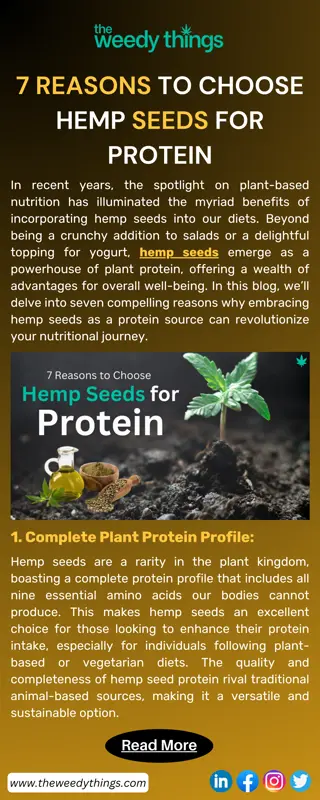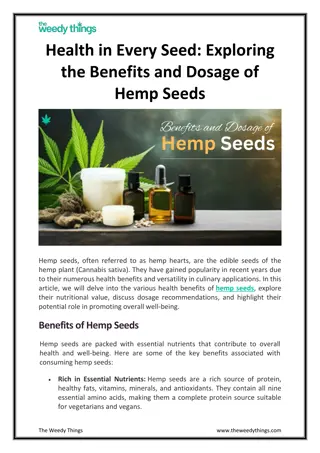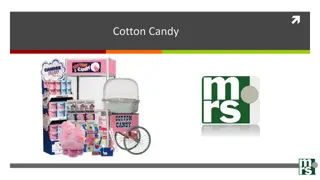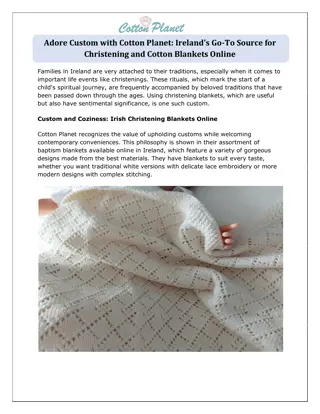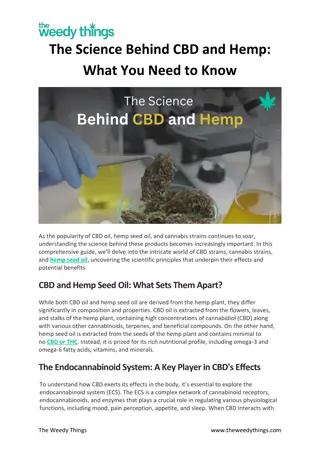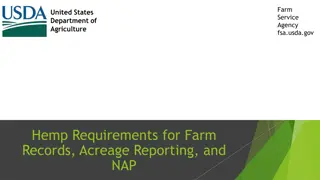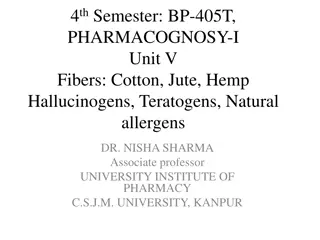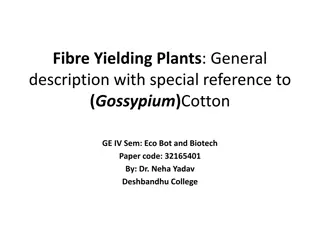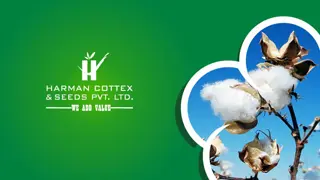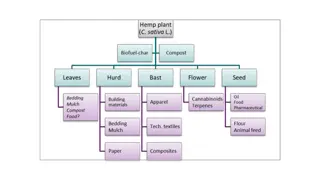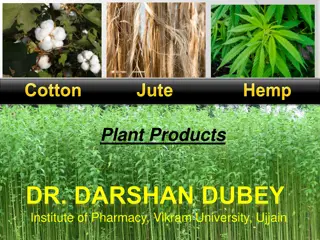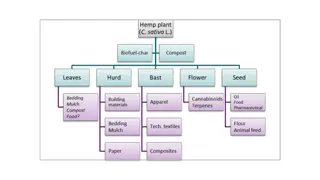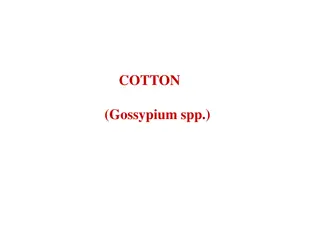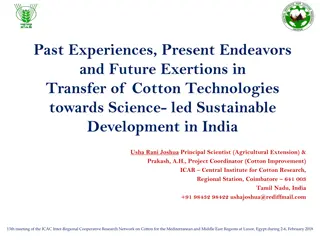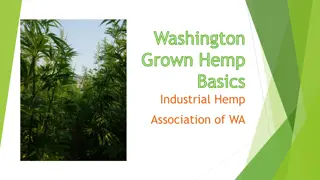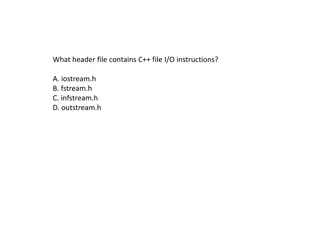
Fibers in Pharmacognosy: Cotton, Jute, Hemp and Their Uses
Explore the world of fibers in pharmacognosy including cotton, jute, and hemp. Learn about their biological sources, chemical constituents, uses, and more. Delve into the classification of natural fibers based on origin and discover the different types of fibers available. Uncover insights into hallucinogens and their effects on altering consciousness.
Download Presentation

Please find below an Image/Link to download the presentation.
The content on the website is provided AS IS for your information and personal use only. It may not be sold, licensed, or shared on other websites without obtaining consent from the author. If you encounter any issues during the download, it is possible that the publisher has removed the file from their server.
You are allowed to download the files provided on this website for personal or commercial use, subject to the condition that they are used lawfully. All files are the property of their respective owners.
The content on the website is provided AS IS for your information and personal use only. It may not be sold, licensed, or shared on other websites without obtaining consent from the author.
E N D
Presentation Transcript
BP-405T, PHARMACOGNOSY-I Unit V Fibers: Cotton, Jute, Hemp Hallucinogens, Teratogens, Natural allergens Dr. Gaurav Ph.D., M.S. Pharm, B. Pharm Assistant Professor, IIMT College of medical Sciences IIMT University, Meerut, Uttar Pradesh https://orcid.org/0000-0002-0530-0788
Fibers Definition: Any hair-like raw material directly obtainable from an animal, vegetable, or mineral source and convertible into nonwoven fabrics such as felt or paper or, after spinning into yarns, into woven cloth. Classification of Natural fibres based on origin: 1. The vegetable or cellulose-base: includes cotton, flax, and jute, banana, hemp 2. The animal or protein-base fibres: wool, silk. 3. Regenerated and synthetic fibres: Nylon, Terylene, Orlon, Viscose, Alginate fibres, etc. 4. Mineral fibre: Asbestos, glass
Cotton : Absorbent/ Raw/purified cotton Biological source: Epidermal trichomes of the seeds of cultivated species of the Gossypium herbaceum and other species of Gossypium (G. hirsutum, G. barbadense) freed from impurities, fats and sterilized, belonging to family Malvaceae. Chemical Constituents : 90% of cellulose, 7 8% of moisture, wax, fat and oil 0.5% and cell content about 0.5%. Purified cotton has almost cellulose and 6 7% of moisture. Chemical Tests: 1. Dry cotton + N/50 I2 + 80% w/w H2SO4 Blue color 2. Dry cotton + ammon. Copper oxide Dissolves with ballooning Uses 1. As filtering medium 2. 2. In surgical dressings 3. 3. As insulating material 4. 4. Absorbent cotton absorbs blood, mucus, pus and prevents from infections.
JUTE : Gunny Biological source: It consists of phloem fibres from the stem of various species of the Corchorus; C. capsularis Linn, C. olitorius Linn, and other species like C. cunninghamii, C. junodi etc., belonging to family Tiliaceae. Chemical Constituents: It composed of 50 53% cellulose, 20% hemicellulose & 10 11% lignin, moisture not more than 12 13%, fats, wax, and ash contributing to 1% each. Chemical Tests: Middle lamella is lignified, gives red color with Phloroglucinol+ HCl. USES: It used in the manufacture of tows, padding splints, filtering, and straining medium. Jute is used for the preparation of coarse bags.
HEMP: Biological source:Hemp is the pericyclic fibre obtained from Cannabis sativa Linn., belonging to family Cannabinaceae.. Chemical Constituents : Mainly composed of cellulose, and some Lignin is present.. USES: printing, inks, paints, varnishes, paper, bibles, bank notes, food,, textiles (the original Levi s jeans were made from Hemp cloth), canvas and building materials. Due to its high tensile strength, bast fibres are ideal for such specialized paper products as: tea bags, industrial filters, currency paper, or cigarette paper.
HALLUCINOGENS Hallucinogens are natural and synthetic (synthesized) substances. When Taken into the body they alter state of consciousness. Hallucinogenic compounds cause people to see/ think to see random colours, patterns, events and objects that do not exist. Other names of hallucinogens are Cartoon acid, Microdot, California sunshine, Psilocybin, Magic mushrooms. Marijuana and hashish two substances derived from the hemp plant (Cannabis sativa)- feeling of relaxation, faster heart rate Form of LSD first produced in 1938, Albert Hoffman, a Swiss research chemist at Sandoz Laboratories, synthesized many important ergot alkaloids (organic plant bases), including Hydergine, LSD-25 and psilocybin. LSD is so powerful that a tiny amount can have a hallucinogenic effect.
HALLUCINOGENS: Datura Biological source: Datura consists of the dried leaves and flowering tops of Datura metel and D. metel var. fastuosa Safford. It belongs to family Solanaceae. contain not less than 0.20 per cent of total alkaloids of Datura, calculated as l- hyoscyamine. Chemical Constituents : upto 0.5 per cent of total alkaloids, among which hyoscine (scopolamine) is the main alkaloid, while l-hyoscyamine (scopoline) and atropine are present in very less quantities (see belladonna herb). USES: its main alkaloid hyoscine are parasympatholytic with anticholinergic and central nervous system depressant effects. The drug is used in cerebral excitement. used in treatment of asthma and cough. Hyoscine hydrobromide is used in motion sickness, gastric or duodenal ulcers.
HALLUCINOGENS: BETEL NUT Biological source: dried ripe seeds of Areca catechu, belonging to family Palmae. Chemical Constituents : arecaine and arecoline alkaloids which are comparable to nicotine in its stimulating, mildly intoxicating and appetite-suppressing effects on the mind. It also contains the alkaloids arecaidine, arecolidine, guracine (guacine) and guvacoline. USES: Arecoline: parasympathomimetic. Sialogogue properties, consumed as masticatory in India. May cause oral leukoplakia. anthelmentic drug and used as vermicide and taenifuge in veterinary practice. Other Hallucinogenics: KAVA KAVA, Henbane, Belladona, Hyoscyamus niger, Argemone mexicana etc.
TERATOGENS: Teratogen is a an agent that can disturb the development of embryo/ fetus. They halt pregnancy or produce a congenital malformation i.e. birth defect. Classes of teratogens : Radiation, chemicals and drugs 1.Tobacco: It consists of dried leaves of Nicotiana tobaccum, belonging to family Solanaceae. CC: alkaloids nicotine, nicotianin, nicotinine, nicoteine, nicoteline. After leaves are smoked the nicotine decomposes into pyridine, furfurol, collidine, hydrocyanic acid, carbon monoxide, etc. USES: sedative, diuretic, expectorant, discutient and sialagogue Nicotine is vasoconstrictor, results in uterine vascular cnstriction and intrauterine growth retardation. Ciggarette smoking during pregnancy results in perinatal mortality & morbidity risk, CO from smoke crosses placenta & ses blood carboxyhemoglobin with long half life in fetal blood.
TERATOGENS: Marijuana or Cannabis B.S. dried flowering tops of the pistillate plants of Cannabis sativa Linn., belonging to family Cannabinaceae. C.C : 15 to 20% resin, The most important active constituents present in cannabis are: cannabidiol, cannabidolic acid, cannabinol, cannabichromene, and trans-tetrahydrocannbinol. Cannabis also contains Cannabidiolic acid, cannabidiol A , 8, 9, tetrahydrocannabinol, cannabinol A9, Tetrahydrocannabinol (THC), volatile oil, trigonelline, and cholene. it is psychotive drug- tetrahydrocannbinol 8,9 tetrahydrocannbinol crosses placenta & persists in fetus for around 30 days. Growth retardation in first trimester Uses: Cannabis resin is tonic, sedative, analgesic, intoxicant, stomachic, antispasmodic, antianxiety, anticonvulsant, antitussive, and narcotic. Cannabis causes only pshycic dependence and act upon the nervous system.
TERATOGENS: Ergotamine from Ergot Fenugreek: Trigonella foenum Asparagus racemosus Malus domestica seeds of apple Prunus cerasus cherry seeds Vinca rosea Veratrum Datura stramonium ETC.
NATURAL ALLERGENS Allergens are inciting agents of allergy, i.e. the substances capable of sensitizing the body in such a way that an unusual response occurs in hypersensitive person. may be biologic, chemical or of synthetic origin. Defined as a specific immunologic reaction to an immunogen a normally harmless substance (allergen). First defined in 1906 by von Pirquet who described allergy as changed or altered reaction in the body of an individual, in response to a substance or condition that is harmless to others.
NATURAL ALLERGENS Types of Allergens 1. Inhalant allergens: airborne substances as chemicals, include pollens, dust, mites, mould spores and animal allergy (epidermis or dander). Pollens produced by plain looking plants, e.g. trees (oak, walnut); grasses (bermuda grass and timothy) and weeds (ragweed, plantain). Alfalfa, almond, apple, acacia, barley, blue grass, canary grass, cherry, eucalyptus, gladiolus, hazelnut, juniper, mulberry, mustard, lemon and related species of citrus. 2. Ingestant allergens: in food stuff and swallowed: skin rash, puffed lips and tongue, migraine, rhinitis or symptoms like severe eczema of hand and feet. Tomato rash, strawberry rash, eating oranges, chocolate or shellfish, walnut, cashew nut, etc. soy lecithin, gluten, soy flour, rice flour, alfalfa, potato starch and gum acacia.
Natural allergens: Dieffenbachia seguine (dumb cane) It is the plant Dieffenbachia seguine belonging to family araceae CC. proteolytic enzyme (named dumbcain), a cyanogenic glycoside, a substance which causes contraction of smooth muscles , asparagine protoaenomoine: swelling of larynx & pharynx Uses: treat gout, dropsy, sexual impotence, and frigidity
Natural allergens :Ruta graveolens Ruta graveolens L., is a odoriferous herb belonging to the family Rutaceae. CC: acridone alkaloids, coumarins, essential oils, flavonoides, and fluoroquinolones have been found in the roots and aerial parts USES: potassium channel blocker, neuromuscular problems, antispasmodic effect Abortifacient Causes photodermatitis

